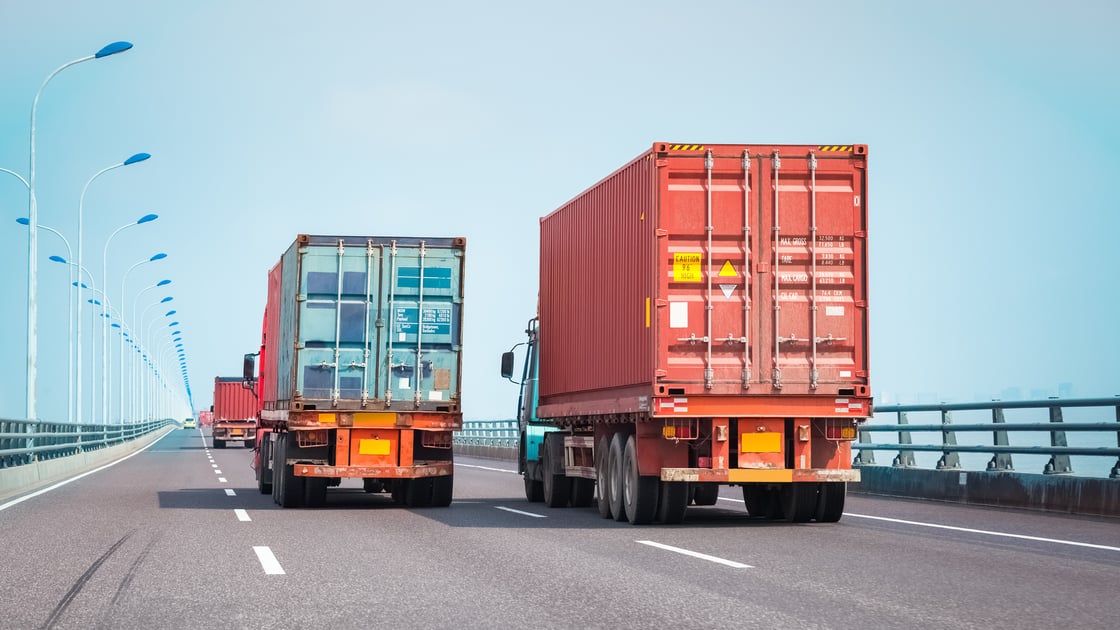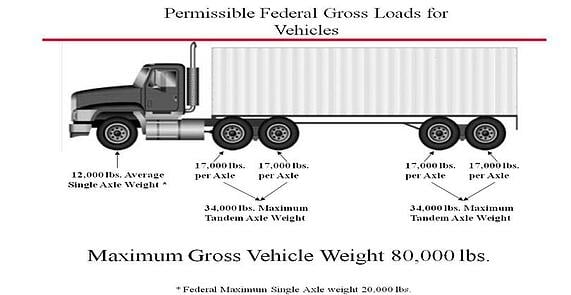
While there are a number of issues shippers need to be aware of when shipping intermodal versus truckload, the most common issue for shippers transitioning their freight from truckload to intermodal is loading the container to be legally compliant with gross weight and the distribution of weight across the vehicle.
Legal Weight Capacity for Intermodal
The Federal Gross Vehicle Weight Limit of 80,000 pounds for tractor/chassis/container is the same for both intermodal and truckload.
The difference between intermodal and truckload lies in the 53' COFC domestic intermodal container weighs roughly 2,500 pounds heavier than a standard dry van. This translates into the recommended maximum bill of lading weight to not be over 42,500 for an intermodal load versus the 45,000 shippers are accustom to for a truckload shipment.
Unfortunately, many shippers entering into an intermodal strategy for the first time are either not properly coached through what needs to be done to account for the intermodal weight difference or they do not take it as seriously as they need to. Either way, not running within the legal weight specifications will cause a great deal of frustration for the shipper, as costs and delays are incurred through reworking the intermodal container to be legally transported.
Shipper is Responsible for Loading Intermodal Container
The intermodal shipper is responsible for the load to be within legal weight limits, which in turn makes them accountable for all costs associated with a load being out of compliance. This responsibility comes as a surprise to many new intermodal shippers. The expectation is load weight and the distribution of weight is the carrier's responsibility, which is understandable considering this is what they have come to expect from their OTR carriers when moving a truckload shipment.
The costs associated with a non-compliant load and re-working it to be legal include: scaling costs, possible fines, additional freight charges, labor cost to rework the load and other charges incurred to make the load compliant. More on the topic of accessorials associated with intermodal can be found by reading Demurrage, Detention, Per Diem & Storage - Definitions & How to Avoid.
Load Intermodal to 42,500 Pounds
The 42,500 pound recommendation is based on the average container, chassis weight and drayage tractor weight.
It is important for the intermodal shipment to be legal at both origin and destination ramps. While the previous statement seems obvious there are reasons why it does not always work out that way when shipping intermodal.
The below scenario is an example that intermodal providers see play out almost every month for new intermodal shippers:
A shipper pushes the weight limit of 42,500 and edges over it. The load remains below the legal 80,000 pound limit because at origin the dray was done with a day cab, with less than half a tank of fuel. The trouble then comes in because the container is pulled at the destination ramp with a larger cab that came straight from a fueling station. The additional weight in the cab and fuel pushes the total weight to be greater than the 80,000 pounds. Now there is an overweight issue.
Since intermodal shipments, by definition, will have different dray equipment on both sides of the transaction this situation does occur. While we see this happen with newer intermodal shippers, it also happens with the most seasoned shippers, as well.
Intermodal Weight Distribution Guidelines
In addition to the Federal Gross Vehicle Weight Limit of 80,000 pounds for tractor/chassis/container gross weight, there is also a weight distribution requirement, which states axle maximums of 12,000 lbs. – Steers; 34,000 lbs. – Drives; and 34,000 lbs. - Trailer/Chassis.
The below diagram illustrates the requirement in more detail. With the weight distribution requirement, there are times where a shipment could be legal on gross, but not on the distribution of weight and vice-a-versa.
Also, much like the gross weight scenario provided earlier, there are other situations where a load is legal at origin, but not at destination because of weight distribution and this is where blocking an bracing is important.
Blocking and bracing is often thought of for protecting the cargo in transit, but there is more. Blocking and bracing also holds the product in place throughout its transit to ensure the weight does not shift and cause the shipment to be overweight on the steers, drives or trailer/chassis.
Like the gross weight requirement, where the shipper is responsible, the distribution of weight is also the shipper's responsibility and they will bear all costs of the rework, as outlined earlier.

Also, shippers should know that some states may enforce additional limits on specific highways or on bridges and California limits the spacing from kingpin to the center of real axle to a 40' maximum.
Conclusion on Intermodal Weight
While all this may sound complicated, it really is not all that cumbersome when a shipper partners with a reputable intermodal provider. The intermodal provider will walk the shipper through the requirements; engage the Class I Railroad for recommended load plans when there are questions; and in the more difficult cases, will send a Class I railroad representative to the shipper's location to provide additional education.
The long and short of it is, the IMC (intermodal marketing company) and the railroad wants the shipper to be successful in the transition of truckload to intermodal, so there are plenty of resources in place to make a smooth transition for the shipper to enjoy the cost savings; the additional capacity; the environmental savings; and the consistent service intermodal brings to the marketplace.
If you're ready to take the next step, at InTek Freight & Logistics, we can help. Just tell us what you need and we'll discuss how our expertise can help with the unique shipping challenges your business faces. Rather do a bit more research first? View our Freight Guides for comprehensive articles and eBooks on all things freight and logistics.
Get Updates
Featured Articles
Categories
- Freight & Shipping Costs (54)
- Freight Broker (60)
- Freight Forwarder (2)
- Intermodal Transportation (184)
- International & Cross Border Logistics (43)
- Logistics & Supply Chain (420)
- Logistics Service Provider (77)
- LTL (39)
- Managed TMS (49)
- News (39)
- Supply Chain Sustainability (12)
- Transportation Management System (37)
- Truckload (122)
- Warehousing & Distribution (50)





